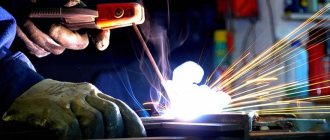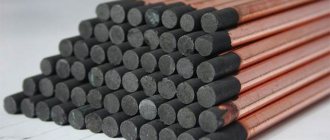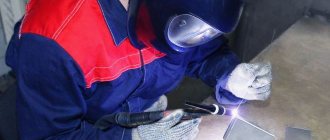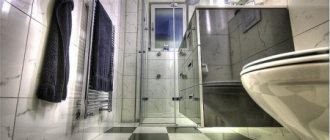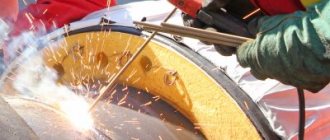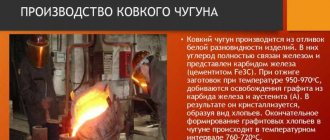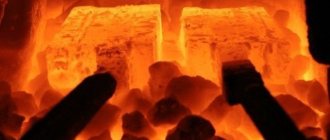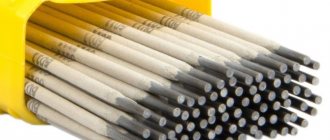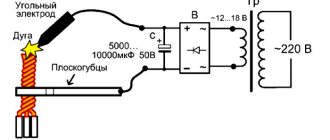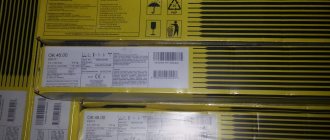Marking, decoding, UD
ANO-4 electrodes have the following designation (marking) – E46-ANO-4-Ø-UD E 43 0(2)-P25, where:
- E46 – type of electrode for arc welding of steels with tensile strength up to 46 kgf/mm2;
- ANO-4 – electrode brand;
- Ø – rod diameter in mm;
- purpose – U – for welding carbon and low-alloy steels with tensile strength up to 451 MPa;
- coating thickness – D – thick coating;
- E – international designation of a consumable coated electrode;
- tensile strength – 43 – 430 MPa;
- relative elongation – 0 – less than 20%;
- minimum temperature at which the impact strength of the weld metal is at least 34 J/cm2 – 2 – 0°C;
- type of coating – R – rutile;
- spatial positions of the electrode at which welding is carried out - 2 - everything except vertical top-down;
- welding current and no-load voltage – 5 – direct or alternating current of any polarity, no-load voltage 70V.
Welding electrodes ANO - 4 (diameter 3; 4; 5 mm)
CLASSIFICATION: E46 according to GOST 9467-75
DESIGNATIONS: E46 - ANO-4 - Ø - UD E 430 - P24
TECHNICAL REQUIREMENTS: GOST 9466-75 and TU BY 100034500.041-2012
COATING: rutile
PURPOSE OF WELDING ELECTRODES ANO-4:
Designed for welding critical structures made of carbon steels with a carbon content of up to 0.25% and with a tensile strength of up to 490 MPa. Allows welding of wet, rusty, poorly cleaned metal from oxides and other contaminants. The electrodes are characterized by easy arc ignition.
Welding in all spatial positions of the seam, except vertical “top-down”, with alternating current and direct current of reverse polarity.
CHARACTERISTICS OF ANO-4 ELECTRODES:
| Arc burning | Sustainable |
| Spray level | Small |
| Seam formation | good |
| Separability of slag crust | good |
| The tendency of the weld metal to form pores | Low |
| Deposition coefficient (in the lower position of the weld) | 8.0-9.0 g/Ah |
| Deposition performance (for electrode with a diameter of 4.0 mm) | 1.4-1.6 kg/h |
| Consumption of electrodes per 1 kg of deposited metal | 1.7 kg. |
TYPICAL MECHANICAL PROPERTIES OF WELD METAL (AT NORMAL TEMPERATURE):
| Tensile strength, MPa | Yield strength, MPa | Relative extension, % | Impact strength J/cm2 |
| 480 | 390 | 20 | 85 |
CHEMICAL COMPOSITION OF WELD METAL:
| Element content, weight% | ||||
| Carbon | Manganese | Silicon | Sulfur | Phosphorus |
| No more | 0,35-0,70 | No more | ||
| 0,12 | 0,20 | 0,040 | 0,045 | |
INSTRUCTIONS FOR USE OF ANO-4:
If the permissible moisture content in the coating is exceeded (1.5%), the electrodes are additionally calcined at a temperature of 140-160 °C for 40-60 minutes before use. WELDING MODES:
| Electrode diameter, mm | Welding current strength, A | ||
| Seam position | |||
| Lower | Vertical | Ceiling | |
| 2,5 | 60-90 | 50-80 | 50-80 |
| 3,0 | 80-100 | 60-100 | 60-90 |
| 4,0 | 120-150 | 110-140 | 110-140 |
| 5,0 | 180-220 | 170-200 | — |
Welding is carried out at an average arc length with the electrode tilted towards the direction of welding (at an angle back).
~ , = / +
Packaging, how many pieces, weight and length of rods
ANO-4 electrodes are produced in cardboard packs, the weight of which is 1; 2.5 and 5 kg.
Average number of electrodes per 1 kg. varies depending on the diameter of the rods and is:
- 3.0 mm. – 39 pieces;
- 4,0 – 16;
- 5,0 – 11.
Depending on the diameter of the rod, the weight and length of the rod .
| Diameter, mm. | Length, mm. | Weight, g. |
| 2,5 | 350 | 18-19 |
| 3,0 | 350 | 25-26 |
| 4,0 | 450 | 58-59 |
| 5,0 | 450 | 91-92 |
| 6,0 | 450 | 137-138 |
DIMENSIONS
1.1. The dimensions of the electrodes must correspond to those indicated in Fig. and in table. .
Crap. 1
Table 1
mm
| Electrode rod diameter d | Electrode coating thickness a | Difference in coating thickness (e=s-s1), no more | |
| Nom. | Prev. off | ||
| 4 | -0,12 | 0.9-1.l | 0,15 |
| 5 | -0,12 | 1,2-1,3 | 0,18 |
An example of a symbol for an electrode of the ANO-4 brand, type E46, 5 mm in diameter with rutile coating
ANO-4-E46-5-T GOST 5.1215-72
Consumption, consumption rates
Electrode consumption is provided in reference format. For ANO-4 brand rods, consumption per 1 kg. deposited metal is 1.6-1.7 kg.
Official documents VSN 452-84 or VSN 416-81 (“Departmental Construction Standards”) also indicate production standards per 1 joint and per 1 meter of seam . These indicators are shown in the form of tables.
It is also possible to calculate the norm yourself. Consumption consists of the mass of deposited metal and losses. First you need to calculate the mass of deposited metal using the formula:
Mass = weld cross-sectional area x metal density x weld length
Density values can be found in reference literature. Then, using the second formula, the total consumption of electrodes during welding is calculated:
Consumption rate = mass of deposited metal x consumption coefficient
The consumption coefficient depends on the specific brand of electrode; for ANO-4 it is 1.7.
These data are provided in regulatory documents such as VSN 452-84. Reference. There are also other methods for calculating the consumption rate.
TEST METHODS
4.1. Inspection of the electrodes is carried out without the use of magnifying devices.
4.2. The deflection of the rods is checked with the maximum caliber.
4.3. The length of the electrodes is checked with a measuring tool with an accuracy of ±1 mm.
4.4. The value of equivalence of coating thicknesses is determined in three places, shifted relative to each other by 50-100 mm along the length of the electrode and by 120° around the circumference. The measurement is made as shown in Fig. .
Crap. 4
Control of the difference in thickness of the coating thickness is carried out with an accuracy of ±0.01 mm.
It is possible to control the concentricity of the coating using special devices (magnetic, capacitive, etc.) without destroying the coating, if these devices provide the necessary measurement accuracy.
4.5. The mechanical properties of the deposited weld metal and welded joint are determined according to GOST 9466-60.
The impact strength of the weld metal aN is determined on type VI samples according to GOST 6996-66.
When exporting, the impact strength of the weld metal АН 45 must also be determined on type IX samples in accordance with GOST 6996-66.
4.6. Welding and technological properties of electrodes are determined according to GOST 9466-60.
4.7. Welding and surfacing of test samples is carried out at a temperature not lower than plus 5°C in the modes specified in table. .
4.8. The chemical composition of the weld metal and deposited metal is checked according to GOST 2331-63 or GOST 2604-44.
4.9. Samples for chemical analysis of weld metal and deposited metal are taken in accordance with GOST 7122-54.
General characteristics of TsCh4 type electrodes
Structurally, elements of this type are rods on which the main coating is applied. They are used for working on high-strength cast iron (with spherical graphite in its composition), as well as for welding products made of gray cast iron (with plate-type graphite).
The functional purpose of these electrodes includes high-quality connection of objects made of dissimilar metals, welding of damaged structural elements, formation of new welds and correction (welding) of various defects that arise during the casting process, special surfacing of initial layers of metal on cast iron parts.
Welding consumable parameters
For high-quality welding work, it is important that all electrode parameters are optimally selected.
This or that practical application influences the choice of the diameter of the specified element - it can vary from 3 to 5 mm. Depending on the upcoming welding operation, it is necessary to set the correct current mode - 65-80, 90-120 or 130-150 amperes.
For high-quality welding work, you need to choose the right electrodes.
For effective operation, the electrodes should be pre-heated. To achieve the best results, it is recommended to do this at a temperature of +170...+200°C.
Chemical composition of the deposited metal
The TsCh-4 model contains the following chemical components:
- carbon (C) – 0.25%;
- manganese (Mn) – 0.5/2.5%;
- phosphorus (P) – 0.07%;
- sulfur (S) – 0.04%;
- silicon (Si) – 0.10/0.80%;
- vanadium (V) – 8.5/10.5%.
The electrode rod has an iron base.
This metal allows you to work efficiently with the material from which the object being welded is made and ensures a high-strength weld.
Symbol and characteristics of coated electrodes
The symbol for electrodes according to GOST 9466 (Fig. 1) provides complete information about their main characteristics. For electrodes that do not belong to the types according to GOST 9467, GOST 10051 or GOST 10052, the type of electrodes is not given in the symbol, and instead of the designation of the standard for the types of electrodes, the designation of the standard or technical specifications for electrodes of a specific brand is indicated. In the designation of electrodes for welding carbon and low-alloy steels with a tensile strength of up to 600 MPa, there is no dash after the letter L.
Designation of the purpose of electrodes 4 (Fig. 1):
- U - for welding carbon and low-alloy structural steels with a tensile strength of up to 500 MPa;
- L - for welding carbon and low-alloy structural steels with a tensile strength of up to 500 MPa, when increased requirements for ductility and impact toughness are imposed on the weld metal;
- T - for welding carbon and low-alloy structural steels with a temporary tensile strength from 500 to 600 MPa;
- B - for welding alloyed structural steels of increased and high strength with a temporary tensile strength of over 600 MPa;
- N - for surfacing surface layers with special properties. Designation of coating thickness 5;
- M - with a thin coating, D/d <= 1.20;
- C - with medium coverage, 1.20
- D - with thick coating, 1.45
- G - with particularly thick coating, D/d > 1.80.
Rice. 1. Diagram of the structure of the electrode symbol:
1 - type; 2 — brand; 3 — diameter, mm; 4 - designation of the purpose of the electrodes; 5 - designation of coating thickness; 6 - group of indices indicating the characteristics of the deposited metal and weld metal according to GOST 9467, GOST 10051 or GOST I0052; 7 - designation of the type of coating; 8 - designation of permissible spatial positions for welding or surfacing; 9 - designation of the type of current used in welding or surfacing, the polarity of direct current and the rated open-circuit voltage of the power source for an alternating current welding arc with a frequency of 50 Hz; 10 - GOST 9466; 11 - designation of the standard for types of electrodes
Designation of type of coating:
- A - sour;
- B - main;
- C—cellulose;
- R - rutile;
- AC, RB, etc. - mixed;
- P - others.
Note: if the coating contains iron powder in an amount of more than 20%, the letter Z should be added to the designation of the type of electrode coating.
Designation of permissible spatial positions of welding or surfacing:
- 1 - for all positions;
- 2 - for all positions except vertical from top to bottom;
- 3 - for lower, horizontal on a vertical plane and vertical from top to bottom;
- 4 - for the bottom and bottom in a boat.
Designation of the type of current used in welding or surfacing, the polarity of direct current and the rated open-circuit voltage of the power source for an alternating current welding arc with a frequency of 50 Hz:
- index 0: DC polarity - reverse (+);
- 1: polarity - any (+/-), UXX transformer - 50V;
- 2: direct (-), 50V;
- 3: reverse (+), 50V;
- 4: any (+/-), 70V;
- 5: direct (-), 70V;
- 6: reverse (+), 70V;
- 7: any (+/-), 90V;
- 8: direct (-), 90V;
- 9: reverse (+), 90V.
Note. The number 0 denotes electrodes intended for welding or surfacing only with direct current of reverse polarity.
Characteristics of deposited metal and weld metal of structural and heat-resistant steels according to GOST 9466-75, GOST 9467-75
An example of the designation of electrodes for welding carbon and low-alloy structural steels with a tensile strength of less than 600 MPa:
(E46A-UONII-13/45-3.0-UD)/( E432(5)-B10) GOST9466-55, GOST9467-75.
Electrodes type E46A according to GOST 9467; grade UONII-13/45, diameter 3.0 mm; for welding carbon and low-alloy steels (U); with thick coating (D); with a group of indices established in accordance with GOST 9467 indicating the characteristics of the deposited metal and weld metal - 432(5); with main coating (B); for welding in all spatial positions (1) on direct current of reverse polarity (0).
An example of the designation of electrodes for welding carbon and low-alloy structural steppes with a temporary tensile strength of more than 600 MPa:
(E85A - UONI - 13 / 85 - 3.0 - LD) / (E-12G2SM-0-B20) GOST9466-75, GOST9467-75.
Electrodes type E85 according to GOST 9467; brand UONI-13/85, diameter 3.0 mm; for welding carbon and low-alloy steels, when increased demands are placed on the metal of the welded seams in terms of ductility and impact toughness (T); with thick coating (D); with a group of indices established in accordance with GOST 9467 indicating the characteristics of the deposited metal and weld metal - (12G2SM-0); with main coating (B); for welding in all spatial positions, except from top to bottom (2) with direct current of reverse polarity (0).
In these electrodes, a group of indices denoting the characteristics of the deposited metal and weld metal indicates the average content of the main chemical elements in the deposited metal, as well as the minimum temperature Tx at KCV > 34 J/cm2. In this case, the first index of the two-digit number corresponds to the average carbon content in the deposited metal in hundredths of a percent. Subsequent indices, consisting of a letter designation corresponding to the main chemical element, and the number behind them show the average content of this element in the deposited metal in percent (with an error of up to 1%). If the average content of the main chemical element in the deposited metal is less than 0.8%, the number behind the letter designation of the chemical element is not indicated.
Table 1. Characteristics of deposited metal and weld metal of carbon and low-alloy structural steels with a tensile strength of less than 600 MPa
Note. In the group of indices, the first two indices indicate the minimum value of tensile strength OB, and the third index simultaneously characterizes the minimum values of relative elongation S5 and the minimum temperature Tx at KCV > 34. If the indicators S5 and Tx correspond to different indices, then the third index denotes S5, and in group of indices, a fourth additional index is introduced, indicated in parentheses, characterizing the Tx indicator.
The main chemical elements, in addition to carbon, include only alloying elements that determine the level of mechanical properties of the deposited metal. In this case, silicon and manganese are considered the main chemical elements if their average content in the deposited metal exceeds 0.8%. The order of arrangement of letter designations of chemical elements is determined by a decrease in the average content of the corresponding elements in the deposited metal. The chemical elements contained in the deposited metal are designated by the following letters: B - niobium, B - tungsten, G - manganese, D - copper, M - molybdenum, N - nickel, C - silicon, T - titanium, F - vanadium, X - chrome, Yu - aluminum.
nThe index after the dash characterizes the minimum temperature Tx at KCV > 34 J/cm2 (Table 2).
An example of the designation of electrodes for welding alloyed heat-resistant steels:
(E-09Х1МФ-ЦЛ39-3.0-TG)/(E-27 - B20) GOST9466-75, GOST9467-75.
Electrodes type E-09X1MF according to GOST 9467; grade TsL39, diameter 3.0 mm; for welding carbon and low-alloy steels (T); with extra thick coating (G); with a group of indices established in accordance with GOST 9467 indicating the characteristics of the deposited metal and weld metal - (27); with main coating (B); for welding in all spatial positions, except from top to bottom (2) with direct current of reverse polarity (0).
In these electrodes, the first index in the group of indices indicating the characteristics of the deposited metal and weld metal indicates the minimum temperature Tx at KCV > 34 J/cm2, and the second index indicates the maximum operating temperature at which the long-term strength of the deposited metal and weld metal is regulated (Table .2).
Table 2. Characteristics of deposited metal and weld metal of structural steels with a tensile strength of more than 600 MPa and alloyed heat-resistant steels
Characteristics of deposited metal and weld metal of high-alloy steels with special properties according to GOST 9466-75, GOST 10052-75
The group of indices indicating the characteristics of the deposited metal and weld metal consists of four digital indices for electrodes that provide the austenitic-ferritic structure of the deposited metal, and three digital indices for the remaining electrodes.
The first index characterizes the resistance of the deposited metal and weld metal to intergranular corrosion. The second index indicates the maximum operating temperature at which the long-term strength of the deposited metal and weld metal is regulated. The third index indicates the maximum operating temperature of welded joints, up to which the use of electrodes when welding heat-resistant steels is allowed. The fourth index indicates the content of the ferrite phase in the deposited metal for electrodes that provide the austenitic-ferritic structure of the deposited metal.
An example of the designation of electrodes for manual arc welding of high-alloy steels with special properties:
(E-10Х25Н13Г2Б-ЦЛ9-3,0ВД)/(E-2075 - B20) GOST9466-75, GOST10052-75.
Electrodes brand TsL-9 (type E-10Х25Н13Г2Б); the deposited metal and the weld metal are not prone to intergranular corrosion when tested according to the AM method GOST 6032-89 (2), there is no data on long-term strength (0), when welding heat-resistant steels they can be used to make welded joints operating at temperatures up to 1000 ° C (7), the content of the ferrite phase in the deposited metal is 3.0-10.0% (5).
Designation of resistance of deposited metal and weld metal to intergranular corrosion according to GOST 6032-89:
- 0—no data available;
- 2 - when tested by AM and AMU methods;
- 3 - when tested by method B;
- 4 - weld metal is not prone to intergranular corrosion when tested by methods B and VU;
- 5 - weld metal is not prone to intergranular corrosion when tested by method D.
Designation of the maximum operating temperature at which the long-term strength of the deposited metal and weld metal is regulated:
- 0 - No data available;
- 1 - Up to 500;
- 2 — 510-550;
- 3 — 560-600;
- 4 — 610-650;
- 5 — 660-700;
- 6 — 710-750;
- 7 — 760-800;
- 8 — 810-850;
- 9 - Over 850.
Designation of the maximum operating temperature of welded joints at which the use of electrodes when welding heat-resistant steels is allowed, C:
- 0 - No data available;
- 1 - Up to 600;
- 2 — 610-650;
- 3 — 660-700;
- 4 — 710-750;
- 5 — 760-800;
- 6 — 810-900;
- 7 — 910-1000;
- 8 — 1010-1100;
- 9 - Over 1100.
Designation of the ferrite phase content in the deposited metal, %:
- 0 - Not standardized;
- 1 — 0,5-4,0;
- 2 — 2,0-4,0;
- 3 — 2,0-5,5;
- 4 — 2,0-8,0;
- 5 — 2,0-10,0;
- 6 — 4,0-10,0;
- 7 — 5,0-15,0;
- 8 — 10,0-20,0.
Characteristics of deposited metal and weld metal during manual arc surfacing of surface layers with special properties according to GOST 9466-75, GOST 10051
The group of indices indicating the characteristics of the deposited metal consists of two indices. The first index indicates the average hardness of the deposited metal (Table 3). The second index indicates that the hardness of the deposited metal is ensured without heat treatment after surfacing - 1 or after heat treatment - 2.
Note. If the technical conditions for electrodes of a particular brand establish the hardness of the deposited metal both without heat treatment after surfacing, and after heat treatment or after heat treatment in various modes, then indicate both indices in parentheses.
Table 3. Hardness of deposited metal
* - to the left of the slash indicate the average hardness of the deposited metal according to Vickers, to the right of the slash - according to Rockwell.
An example of the designation of electrodes for surfacing surface layers with special properties:
(E-37H9S2-OZSHZ-3.0-ND)/(E -650/57 -1 - B30) GOST9466-75, GOST10051-75.
Electrodes of the OZSh-3 brand, type E-37Kh9S2, providing the average hardness of the deposited metal (650 HV; 57 HRCe), without heat treatment after surfacing
Conditions for using electrodes
Used when necessary:
- core coating;
- in the event that the product is defective, their defects are welded using the injection molding method;
- welding coefficient, g/A-hour - 10.0;
- produced surfacing, for a central electrode with a diameter of 4.0 mm, kg/hour - 1.1;
- number of consumable electrodes per 1 kg of deposition, 1.8 kilograms;
- before starting welding, it is necessary to clean and degrease the parts using chemicals and grinding agents;
- the whole process occurs under voltage with reverse polarity;
- it is possible to work with alternating transformer voltage (more than 60 V);
- the work is carried out with small shafts, ranging in length from 25 to 30 mm, cooled by the environment and hammer blows on the seam and around it up to 60 ° C;
- When performing work with cast iron, which has high strength, the length of the roller is increased. Its size is from 80 to 100 mm.
Figure 3 - Welding process
Currently, there is no known method by which parts made of different materials can be fastened to each other. In order to connect or correct defective defects (make welding) of forged high-quality cast iron, we apply the welding method using a TsCh-4 electrode. It has excellent technical data and universal application properties.
Classifications and approvals
Welding electrodes TsCh-4 meet the technical specifications of TU U 28.7-34142621-006:2012 and are approved by:
- TUV – Association of audit companies of the Union of Technical Supervision of Boiler Equipment Facilities (Germany);
- STB – Gosstandart (Republic of Belarus);
- KZ-standard – GOST 9466 (Republic of Kazakhstan);
- MD-standard – GOST 9466 (Republic of Moldova).
We recommend reading Where OZL-6 electrodes are used
Welding electrodes TsCh-4 are approved by TUV, STB.
